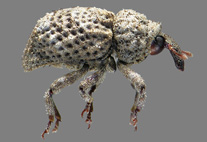Abstract
A molecular phylogeny of the western Palearctic weevil genus Dichromacalles Stüben, 1998, is presented, combining two mitochondrial genes, COI and 16S, and the nuclear gene 28S in a Bayesian analysis of up to 1528 combined nucleotide positions. Based on this data we point out the putative ancestor of the currently known extant Dichromacalles species that initiated the unique radiation within the species of the formerly Acalles s.l. on the Canary Islands around 10 to 20 million years ago. Where morphology reaches its limits in species differentiation, molecular analysis can provide deeper insight. By combining morphology and molecular biology into an integrative taxonomy, new characters can be found, making phenotypic descriptions easier. Using this integrative taxonomy background, the new species Dichromacalles algecirasensis Stüben (Spain: Cádiz) is described here and D. lentisci (Chevrolat, 1861) is transferred into the subgenus Balcanacalles Stüben & Behne, 1998 following a molecular phylogenetic reconstruction. A catalogue of all 12 species of Dichromacalles is given and a key is presented, combined with image stackings of the habitus and aedeagus for all species.

